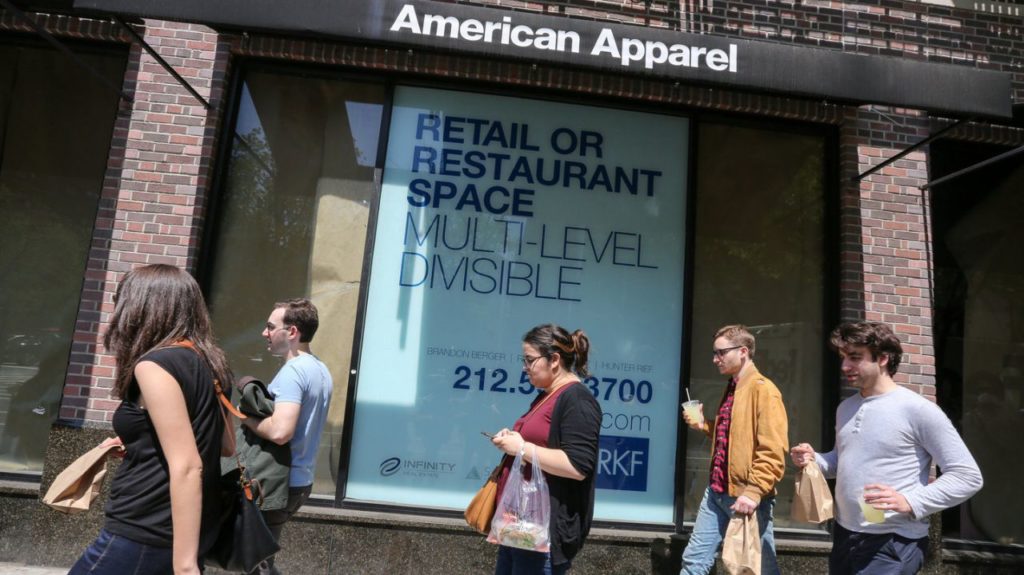Retail is big news in 2017. Online and offline media have been reporting the “death of the high street” and the seemingly inevitable “retail apocalypse” for months now. The flood of bad retail news shows no signs of waning as big-name stores continue to close doors.
New York is at the forefront of the market turbulence and vacancy rates are at a near-record high in SoHo, which was, until recently, the most highly sought after neighborhood for brands. Now rental rates in SoHo have dropped 7.6% since 2015.
To the global community, New York is the canary in a mine of closing stores and dead shopping malls throughout the US.
But, as surprising as it might seem, there are always ways to take advantage of the “Retail Crisis in NYC”.
1. Monitor Competitor Closures
As brutal as it sounds, hearing that a company has gone into administration or is closing a number of its stores means vacant space for growing brands. Take American Apparel, known for having multiple stores across NYC and many cities all over the world. When they announced they were closing the doors all their New York stores, Storefront listed those spaces within days, giving brands instant access top-level retail space. Staying up-to-date on what’s closing where will give you a vital advantage: time. For example, Ralph Lauren will leave 5th Avenue. That gives you time to activate your team, be highly reactive and pounce on a retail gem.
- Set up some Google Alerts so you don’t have to scour the news everyday e.g store closure NYC.
- Be ready: agility is key in today’s retail climate. Having an action plan for when you find your perfect space will pay-off in the long-run.
- Make yourself heard, let Storefront know that you’re looking for retail space for the short-term and we’ll help to make it happen.
- Having an element of flexibility will also make the journey from online to offline easier for you. Start with a window or time rather than a concrete start and end date and you’re more likely to get the space you want.
2. Pop-In Pop-Out Retail
Take advantage of high footfall areas for short periods. Be smart with your budget and weigh up the objectives of your store. If your main aims include gaining exposure, building hype, driving engagement and creating a dynamic in-store experience, it’ll pay to be somewhere busy. Spend a little more for a little less time and you’ll be able to rent a top retail unit. Just be sure to market the event like you’ve never marketed before. The ‘get it while it lasts’ FOMO is a real driving factor in shopper habits.
Another key point to keep in mind is that 32% of shoppers visit stores when they’re first thinking about a purchase, and 33% actively research in stores to find out more about a potential purchase. So taking a vacant store in the heart of your customer’s favorite neighborhood for 2 weeks will boost your online sales for weeks and months to come.
- Define where your customers shop and where your competitors are.
- Take a look through vacant spaces in the area to gauge the rental costs.
- Set your budget and your timeline.
- Select and book your perfect retail space.
- Promotion offensive – make the most of social media, influencers and good old fashioned flyering.
- Set-up shop and open doors. For more information on smart store design, POS and marketing and so on, download our free Pop-Up Guide.
3. Learn from other’s mistakes
There have been 9 retail bankruptcies in the US in 2017. Household names like Sears, JCPenney, Kmart and Macy’s have all announced huge store closures. The error being too much space – yes there is such a thing. The sheer amount of retail space in the US outnumbers other countries 10-fold.
- American Apparel had bad press for years, with scandal surrounding the CEO the brands reputation crashed.
- Many traditional stores have digital screens in store that provide little value.
- Lack of presence on social media. Brands are know to ‘not care’ about social media, which is the only way to connect with Generation z. Nordstrom is one brand who have handled this particularly well. They use Pinterest to track the success of their products.
- Social feedback validation is hyper important, retail must keep up to date with social media and be open to feedback.
- Macy’s main issue was they were unable to adapt to the new era of retail that we’re currently in, which led to the brand’s downfall while tech-savvy brands prospered.

How to stay ahead
- Care about feedback – be open and use data-driven results so you can understand changing consumer preferences and utilize consumer insights.
- Embrace the future and break into AI. Use automation to create personalized communications with your entire audience, so each individual feels valued.
- Multichannel is the way to the future. Ensuring your customers can travel through your sales funnel on any device will make your products easily accessible. At the same time, you’ll develop a level of trust with your customer, knowing that they can reach you at any time.
4. Exploit Seasonality
Online sales raked in a staggering $91.7 billion during the holiday season in 2017. And given that 96 % of shoppers who buy from a retailer’s website also visit that retailer’s brick-and-mortar stores, having a physical space – even for a short while – will put you in the forefront of your customers mind. By renting a store only for the busy periods of the year, you capitalize on consumer habits without running the risks that come with taking out a long term lease.
- Nail down your customer profile and define the season you’re aiming for.
- Research holiday spending habits to find out when and where your target are spending.
- Keep in mind your neighborhood in relation to price point – who are your ideal neighbors?
- Think ahead; if you want a space for Christmas, aim to book during spring to early summer that year.
- Stay up to date on events. Know the notable public goings-on that will affect your location and sales.
- Build a stellar marketing campaign and be vocal in unique ways, engaging your audience and creating multiple reasons for people to visit, other than your products.
As New York struggles to fight the supposed landslide to online shopping, there have been a few near fruitless attempts at clawing back customers lost to the eCommerce world. One of which received a scathing review from the NY Daily News explaining how New Yorkers were expected to tally up their tax savings from shopping online and submit to the state. Filing taxes is tedious at the best of times so this ‘honor system’ is set to fail.
“The ‘retailpocalypse’ is exaggerated, our industry is in ‘retailmutation’ & experience is the new currency” Mohamed Haouache, Storefront CEO
- Pop Up 101: How To Design Your Pop-Up Store Layout - September 7, 2020
- 5 Reasons Why Your Brand Should Host a Holiday Pop-Up Store - December 10, 2017
- 4 Ways To Capitalize On The “Retail Crisis” in NYC - August 4, 2017





